
A Carnot engine operating in reverse as a heat pump moves heat from a cold reservoir at 7°C to a warmer one at 22°C.
a. What is the efficiency of a Carnot engine operating between these two temperatures?
b. If the Carnot heat pump releases 250 J of heat into the higher-temperature reservoir in each cycle, how much work must be provided in each cycle ?
c. How much heat is removed from the 7°C reservoir in each cycle?
d. The performance of a refrigerator or heat pump is described by a “coefficient of performance” defined as K = Qc/W. What is the coefficient of performance for our Carnot heat pump?
e. Are the temperatures used in this example appropriate to the application of a heat pump for home heating? Explain.
(a)
The efficiency of the Carnot engine.
Answer to Problem 3SP
The efficiency of the Carnot engine is
Explanation of Solution
Given info:
Temperature of hot reservoir is
Write an expression to calculate the efficiency.
Here,
Substitute
Thus, the efficiency of the Carnot engine is
Conclusion:
The efficiency of the Carnot engine is
(b)
The work provided in each cycle.
Answer to Problem 3SP
The work provided in each cycle is
Explanation of Solution
Given info:
Heat released to hot reservoir is
Write an expression for work provided in each cycle.
Here,
Substitute
Thus, work provided in each cycle is
Conclusion:
The work provided in each cycle is
(c)
The heat released from cold reservoir.
Answer to Problem 3SP
The heat released from cold reservoir is
Explanation of Solution
Write an expression for heat released from cold reservoir.
Here,
Substitute
Thus, the heat released from cold reservoir is
Conclusion:
The heat released from cold reservoir is
(d)
The coefficient of performance of the heat pump.
Answer to Problem 3SP
The coefficient of performance of the heat pump is
Explanation of Solution
Write an expression for coefficient of performance of the heat pump.
Here,
Substitute
Thus, the coefficient of performance of the heat pump is
Conclusion:
The coefficient of performance of the heat pump is
(e)
The possibility of application of the heat pump for home heating.
Answer to Problem 3SP
Yes, the heat pump can be used for home heating.
Explanation of Solution
For home heating only moderate energy range is required. That will be sufficient to increase the temperature of home slightly. Here for working of the pump, only moderate range of energy is required.
Since the energy required is moderate, the energy provided by the heat pump will be adequate. The energy release will be less compared to the energy required to run the heat pump.
Conclusion:
Yes, the heat pump can be used for home heating.
Want to see more full solutions like this?
Chapter 11 Solutions
Physics of Everyday Phenomena
- 8. With the aid of a diagram draw the following electric circuit and use the resistor as the load, (a) Closed circuit (b) Open circuitarrow_forwardLab 8 Part 3 PHET Wave Interface simulation. I am having trouble with this part of the lab.arrow_forwardMick and Rick are twins born on Earth in the year 2175. Rick grows up to be an Earth-bound robotics technician while Mick becomes an intergalactic astronaut. Mick leaves the Earth on his first space mission in the year 2200 and travels, according to his clock, for 10 years at a speed of 0.75c. Unfortunately, at this point in his journey, the structure of his ship undergoes mechanical breakdown and the ship explodes. How old is Rick when his brother dies?arrow_forward
 Physics for Scientists and Engineers: Foundations...PhysicsISBN:9781133939146Author:Katz, Debora M.Publisher:Cengage Learning
Physics for Scientists and Engineers: Foundations...PhysicsISBN:9781133939146Author:Katz, Debora M.Publisher:Cengage Learning College PhysicsPhysicsISBN:9781938168000Author:Paul Peter Urone, Roger HinrichsPublisher:OpenStax College
College PhysicsPhysicsISBN:9781938168000Author:Paul Peter Urone, Roger HinrichsPublisher:OpenStax College
 Physics for Scientists and Engineers, Technology ...PhysicsISBN:9781305116399Author:Raymond A. Serway, John W. JewettPublisher:Cengage Learning
Physics for Scientists and Engineers, Technology ...PhysicsISBN:9781305116399Author:Raymond A. Serway, John W. JewettPublisher:Cengage Learning Physics for Scientists and EngineersPhysicsISBN:9781337553278Author:Raymond A. Serway, John W. JewettPublisher:Cengage Learning
Physics for Scientists and EngineersPhysicsISBN:9781337553278Author:Raymond A. Serway, John W. JewettPublisher:Cengage Learning Physics for Scientists and Engineers with Modern ...PhysicsISBN:9781337553292Author:Raymond A. Serway, John W. JewettPublisher:Cengage Learning
Physics for Scientists and Engineers with Modern ...PhysicsISBN:9781337553292Author:Raymond A. Serway, John W. JewettPublisher:Cengage Learning





